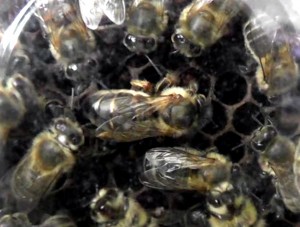Blog – bees, beekeeping & other sticky subjects
Due respect, but …
The goings-on in the observation hive are a little confusing to me.
First of all, the queen seems to have mated sooner than I realised. She now has her retinue and a clear path through the colony, but she appears to be laying only drone eggs.
I’ve read that queens can take some time to start a good laying pattern, but she has been laying for a few days now and I can see only drone cells as a result.
Vita’s Guest Beekeeper Blogger
Gaining a following
Although I’m almost certain she hasn’t mated yet, the queen in the observation hive seems to be attracting a following.
The picture (left) shows the first signs of a retinue forming, but it is a bit sporadic and not a permanent feature. Nonetheless, the workers are doing all the right things by touching her with their antennae to pick up some of her pheromones. There is no sign of harassment, although some workers show her no deference!
I suspect she will mate tomorrow when the sun is forecast to be shining all day.
For the moment, she promenades around the hive frequently going through the motions of egg-laying without actually laying anything. And every time she passes an old queen cell, she takes a lot of interest in it — just checking for rivals, I suppose!
(Please forgive the photos — I am looking for a light tent to minimise the reflections.)
Vita’s Guest Beekeeper Blogger
The ever-present varroa threat
I was just beginning to feel very pleased that I hadn’t seen any sign of varroa mites in the observation hive, when one of the little pests was exposed.
I was videoing a bee being groomed (perhaps for varroa) centre-screen when the underside of another bee came into view (top left). And yes, there, as plain as could be, was a varroa mite clinging to its underside. There might even be another mite on the wing of the adjacent bee,
Vita’s Guest Beekeeper Blogger
Waiting for mating
It’s Day 5 or maybe Day 6 since the emergence of the queen in the observation hive and if the weather were better there might have been some rather exciting aerobatics. But it’s been cloudy and cool for the past few days and although the queen is probably mature enough to mate, she hasn’t ventured outside (I don’t think so anyway!).
The books say that as time goes on she will be harassed, probably to encourage here to leave the hive to mate, but all seems relatively quiet for the moment even though she still has to struggle to walk through the colony and is shown no deference.
In reading up about the mating process, I’ve been surprised to read about the possible purpose of an activity frequently seen by beekeepers: the massing of flying bees in flight in front of a hive. I’d always been told that this was probably young bees on orientation flights for the first time, but research has shown that all ages of bees are to be found in these mass flights! The flights may be practice for mating flights of the queen — or even the real thing. They don’t happen if no queen is present in the hive says Jurgen Tautz in his beautifully illustrated and fascinating book The Buzz about Bees: Biology of a Superorganism.
Vita’s Guest Beekeeper Blogger
The struggles of a virgin queen
Most beekeepers will be very familiar with the stately progress of a mated queen through a colony with bees making way for her ahead and a changing retinue of workers licking and touching her as she goes on her royal progress. But life as a virgin queen is decidedly different.
The virgin queen in this short video clip of the observation hive emerged one, possibly two, days ago. As an unmated queen, she is not afforded the special treatment of a mated queen and she must struggle through the mass of bees, clambering over workers and being walked over herself. She can be quite difficult to spot even in an observation hive because she is often obscured from view.
She will not go on her first mating flight until she is more mature, perhaps when she is 4 or 5 days old — if the weather is suitable. But I can expect to see her being harassed by the workers as she matures until she is fully mated (which may take several mating flights). It’s thought that the increasing harassment is to encourage her to leave on a mating flight before she gets too old.
So I await with interest to watch for the harassment to begin. Apparently she might even start piping if the harassment gets too much for her because by making a noise she can get the workers to freeze on the spot and get some respite.
Mark L Winson’s book The Biology of the Honeybee, chapter 12, gives a very good description of what is happening in the hive of a virgin queen.
Vita’s Guest Beekeeper Blogger



